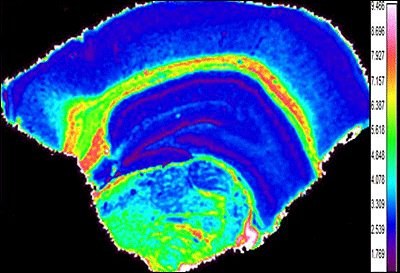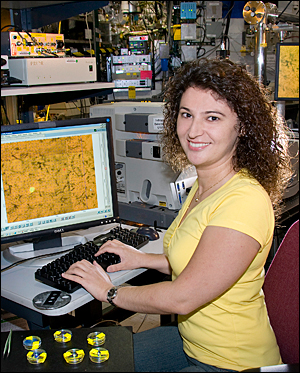International Collaborations, Funding Help Open the Secrets of Radiation-Protective Drugs
October 21, 2008
Radiation therapy - the medical use of ionizing radiation to destroy or deactivate cancer cells - can spur numerous side effects when healthy tissues surrounding the cancerous cells are also destroyed. To avoid these unwanted effects, which can range from difficulty swallowing to bladder and lung inflammation, doctors give radiotherapy patients a radioprotective agent that acts as a shield for healthy cells. Amifostine is the only radioprotective agent approved by the U.S. Food and Drug Administration, yet research about this drug is mostly conducted on a clinical level alone. To gain a molecular-level understanding of the protective role of amifostine, Gulgun Cakmak, a graduate student in Feride Severcan's Molecular Biophysics Laboratory at the Middle East Technical University, is using powerful beams of infrared light at the National Synchrotron Light Source (NSLS) to study samples of irradiated brain tissue from rats.
Cakmak, who is from Ankara, Turkey, is working on her Ph.D. thesis at NSLS beamline U10B alongside NSLS biophysicist Lisa Miller. After studying samples in her home laboratory, she came to the NSLS in April to use a synchrotron technique called Fourier transform infrared microspectroscopy (FTIRM).
"The brain is a complex organ with both structural and chemical heterogeneity," Cakmak said. "We performed some analysis of the rat tissues in Turkey, but because we didn't have access to a synchrotron, we could only study isolated membranes, and were unable to study the composition of individual cells and their surrounding tissue. FTIRM enables a correlation between chemical information and histological structures by high-resolution imaging without destruction of the tissue."
To fund her research, Cakmak received a $9,000 scholarship from the Scientific and Technical Research Council of Turkey (TUBITAK). In addition, she received $2,500 from the NSLS and a $2,000 grant from the U.S. Department of Energy's (DOE) Cooperative Research Program for SESAME, which stands for Synchrotron-light for Experimental Science and Applications in the Middle East. This new light source facility, currently under construction in Jordan, is bringing together scientists from several Middle Eastern countries. Since it was first funded in 2000, the Cooperative Research Program for SESAME has benefited more than 20 Middle Eastern scientists.

FTIR image of the distribution of the lipids in rat brain tissue.
Although her project won't be complete until November, Cakmak has already made some preliminary findings by comparing the irradiated brain tissues of amifostine-treated rats to those exposed without the radioprotective drug. In general, radiation of the rats led to a change in the lipid (fat) composition of the brain, suggesting that the lipids in the brain are very susceptible to radiation damage. This effect was not present in rats treated with amifostine before being exposed to the radiation, indicating that the drug protects these systems.
"This shows that amifostine really is protecting normal tissues from the effects of radiation even at a molecular level," Cakmak said. "By understanding how this radioprotective agent works on a molecular level, we might be able to contribute to the development of similar drugs that can improve the quality of life for cancer patients."
In addition to Severcan and Miller, Cakmak is working with Faruk Zorlu from the Department of Radiation Oncology at Hacettepe University.
2008-934 | INT/EXT | Newsroom










